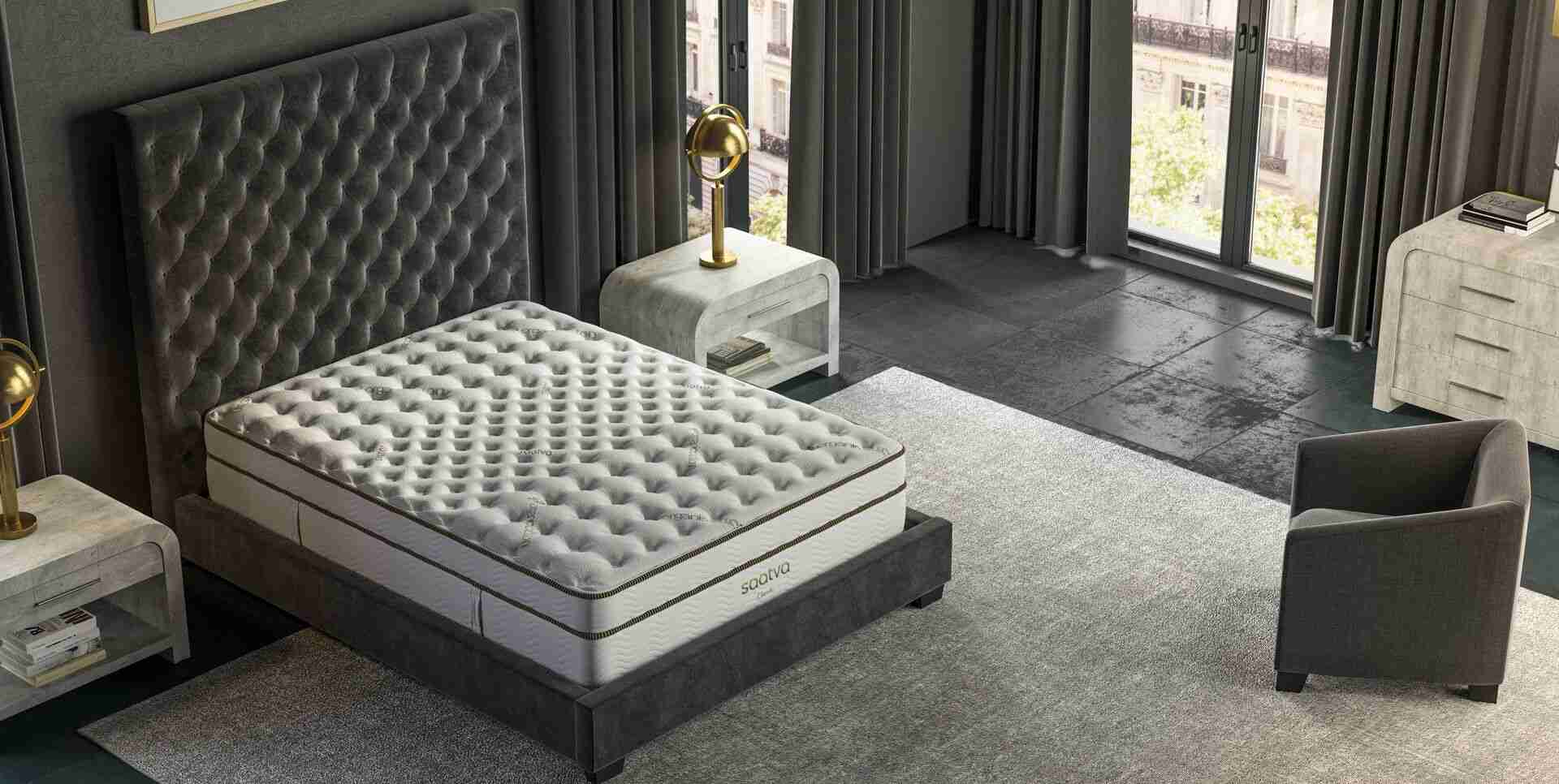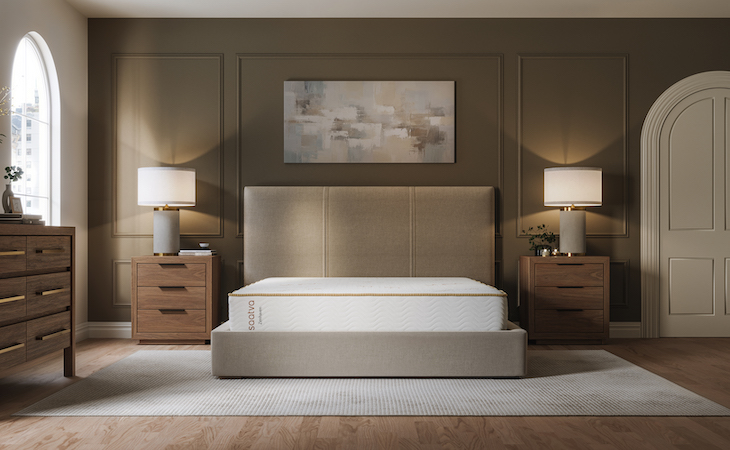So you’re looking for a new mattress and you’re trying to determine what firmness level is right for you. You can find mattresses on the market ranging from extra soft to extra firm.
Most people tend to prefer medium or medium-firm mattresses, as they’re not too soft, not too firm and suit a wide variety of sleepers.
But how can you determine if a medium mattress is the right fit for you?
Let’s take a look at a few different firmness levels, mattress types, and potential benefits of medium mattresses.
Medium mattress firmness levels
While there’s no universal measure of mattress firmness, most mattress companies use a scale of 1 to 10, with one being the softest and 10 being the firmest. A medium mattress is typically in the 4-7 range on the firmness scale.
Medium mattresses come in three distinct firmness levels: medium-soft, medium, and medium-firm.
Medium-soft mattresses
A medium-soft mattress will be a little softer than a medium mattress and usually measures around a 4 on the firmness scale. These mattresses are a little plusher and softer than medium or medium-firm mattresses, while still offering some support to your back and neck throughout the night.
Medium-soft mattresses are usually foam mattresses like memory foam, gel memory foam, and latex foam.
Medium mattresses
Medium mattresses traditionally fall on the center of the firmness scale, measuring in at about a 5. These are the true middle-of-the-road mattresses and offer plenty of support while still being soft and plush.
A medium firmness level can be found in almost any type of mattress, including innerspring, hybrid, memory foam, and latex foam.
Medium-firm mattresses
Medium-firm mattresses will typically fall into the 6-7 range on the firmness scale. These beds are still relatively plush but have an extra level of firmness and added support.
Medium-firm mattresses can come in multiple different types but will most commonly be either innerspring mattresses or hybrid mattresses.
Medium-firm mattress types
When shopping for a mattress, you should consider the type of mattress you’re buying in combination with the firmness level. Each type of mattress will have individual benefits and can make or break your sleep experience.
Let’s take a look at the key factors that affect your decision on mattress type.
Mattress Type Motion Isolation Edge Support Temperature Regulation Mattress Feel Innerspring Mattresses Low – coils make it hard to move unnoticed High – coils add additional edge support to prevent sagging High – innersprings have great airflow and are incredibly breathable – Bouncy and springy
– Most come in medium-firmMemory Foam Mattresses High – thick layers of foam make it hard to notice movement Low – foam tends to sag easier on the edges Low – little airflow through the thick foam layers Plush and soft
– Can come in either medium or medium-firmGel Memory Foam Mattresses High – foam layers make it hard to notice movement Low – foam tends to sag easier on the edges High – cooling technology in the top layer of gel foam makes this mattress cooler to sleep on Plush and soft
– Can come in either medium or medium-firmHybrid Mattresses Medium – the coils are padded, so you tend to feel less movement High – coils add additional edge support High – hybrid coils use a cooling technology for improved airflow – Bouncy but usually have a soft pillow top
– Mostly come in medium-firmLatex Foam Mattresses High – foam layers make it hard to notice movement Low – tends to sag easier towards the edges Medium – better airflow than memory foam but not quite as good as innerspring or hybrid – Plush and soft
– Can come in either medium or medium-firm
Benefits of medium mattresses
There are many situations in which a medium-firm mattress can be the right choice for you. Here are the top three medium-firm mattress benefits:
Can help relieve back pain
If you suffer from back pain, your mattress can literally make or break your sleep. When it comes to mattress firmness specifically, a survey of 268 people from Harvard Health Publishing suggests people with lower back pain sleep best on a medium-firm mattress.
Medium-firm mattresses are great for people with back pain. They contour to your body, giving cushion while still supporting pressure points along your back and neck throughout the night.
Provides ideal support for smaller body types
People who are light or average weight generally need slightly softer sleeping surfaces to keep their bodies properly supported. If you weigh between 120 and 230 pounds, a medium-firm mattress is best.
If you weigh over 230 pounds, on the other hand, you’ll do best on a firm mattress since it’ll help keep your spine aligned without sagging. Check out our blog post on the best sleeping positions for heavier body weights.
Good middle ground for couples
If you sleep with a partner who has a different firmness preference than you, a medium or medium-firm mattress can be a game-changer.
If one of you wants to go firmer and the other softer, a medium mattress provides a good middle ground to keep you both happy, comfortable, and sleeping well throughout the night.
Who are medium mattresses best for?
Keeping your sleeping position in mind is crucial when deciding on a mattress.
While your comfort level is dependent on personal preference, medium and medium-firm mattresses are better for some sleeping styles than others.
Let’s take a look at the best types of sleepers for medium and medium-firm mattresses.
Back sleepers
If you sleep on your back, you want your mattress to have enough give to be comfortable for your lower back and to promote proper spinal alignment. A mattress that’s too soft will cause your back to sink into your bed too much—but a mattress that’s too firm won’t provide enough support in the lumbar area. That’s why back sleepers will do best with a slightly firmer mattress.
Side sleepers
As a side sleeper, you want softness to cushion your hips and shoulders—but a too-soft bed isn’t a good option either. That’s because this could cause you to sink too far into the surface of the mattress, throwing your spine out of its natural alignment. This can lead to back and neck pain. A medium-firm mattress offers the sweet spot you need as a side sleeper.
Stomach sleepers
Sleeping on your stomach is widely considered the worst position for sleep. It’s hard, even with a softer mattress, to get your spine into a neutral position, causing back and neck pain from the extra pressure.
A medium-firm mattress can give stomach sleepers the extra support they need along the spine while still feeling comfortable.
Combination sleepers
If you’re a combination sleeper—meaning you tend to switch between your side and back at night—a medium-firm mattress is a great option for you. It provides enough cushion to cradle your hips and shoulders while you’re on your side and will help keep your spine in alignment while you’re on your back.
FAQs
What is a medium-firm mattress good for?
A medium-firm mattress is good for relieving back pain, providing ideal support for smaller body types, and satisfying different sleep needs that you and your partner may have.
Is a medium-firm mattress good for back pain?
A medium-firm mattress is great for back pain as it can contour to your body, giving a cushion while still supporting pressure points along your back and neck throughout the night.
Check out Saatva’s collection of high-quality medium mattresses
If you’re in the market for a new bed, Saatva has some of the best medium-firm mattresses out there. From our

America’s best-selling online luxury innerspring
to our

The most luxurious memory foam with adaptive cooling & body-hugging support
to our

Our dual-sided organic natural latex mattress for buoyant, pressure-relieving comfort
, we’ve got options for everyone—no matter what your sleep preferences are.
If you’re still unsure which of our products is the best mattress for you, take our online mattress quiz to discover which Saatva bed is the perfect match for you.
Take advantage of our standard 365-night sleep trial and industry-leading warranty so you can make sure you’re getting a good night’s sleep before committing to a mattress.










